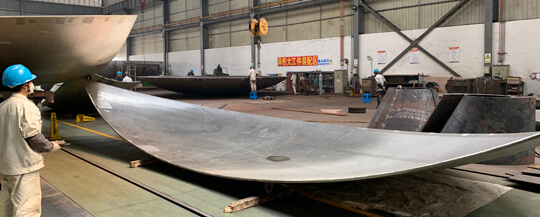According to 86 of the "Technical Supervision and Inspection Regulations for Pressure Vessel Safety", when the wall thickness of the pressure vessel is less than or equal to 38mm, the butt joints should be tested by radiography; the non-destructive testing uses X-ray testing for the welded joints of Class A and B. The cost is higher , Low efficiency, strict on-site testing conditions, and a certain degree of danger. Some harmful defects are not easy to detect (such as the edge of the groove is not fused, not fully penetrated, etc.).
According to Article 4.5.3.1 of the new regulation "Safety Technical Supervision Regulations for Fixed Pressure Vessels", "butt joints of pressure vessels should be radiographic or ultrasonic. Ultrasonic testing includes TOFD and recordable pulse reflection. Ultrasonic detection and non-recordable pulse reflection ultrasonic detection. When non-recordable pulse reflection ultrasonic detection is used, ray detection or diffraction time difference ultrasonic detection should be used as an additional local detection."
For example, the use of diffraction time-difference ultrasonic testing (TOFD), which has just begun in China, has not been popularized by equipment and technical personnel. In many cases, it does not have the testing conditions (such as the type B butt joint of the head and cylinder group). Although ultrasonic testing has a history of several decades in China, the technology is relatively mature, and professional non-destructive testing technicians are more popular. However, the type B butt joint of the ultrasonic non-destructive testing head and the barrel group is not satisfactory. JB/T4730.3-2005 "Non-destructive testing of pressure equipment" Article 5.1.4.1 is greater than or equal to the "2.5KT" provisions, and X-ray testing habits and regulatory agencies have no standards to follow, basically do not use ultrasonic testing.
In the supervision and inspection work, it is often found that due to the limitations of the non-destructive testing personnel and the impact of X-ray detection sensitivity, many hazardous welding defects have not been detected. Such as: automatic welding longitudinal end cracks, gas shielded welding and manual arc welding grooves are not fused (mostly rated as surface defects), etc. Some are misjudgment, for example: X-ray flaw detection is judged as crack, but it is actually electrostatic photosensitive.
Making typical manual welding defects
A cylinder of φ1000×10 is used for pairing with the head. Various butt welding methods are used for group butt welding to produce artificial typical welding defects.
Making crack
Take 300mm welding parts, and use normal electrode arc double-sided welding for 100mm on both sides. The middle 100 mm is not welded, a single-sided "V" groove is opened, the height of the straight edge is 2 mm, and the gap of the groove is 5 to 6 mm. The first pass of argon arc welding is used for bottom welding, and the method of heating by gas welding and water spray cooling after welding relies on the internal stress of thermal expansion and contraction to cause cracks. Use this method three times in a row to make the crack grow. Welding electrode arc welding is performed on the front side, and the back of the argon arc welding is cleaned and polished on the back side.
Making unmelted edge of side bevel of head
A groove with a length of 20 mm and a depth of 3 mm at the same angle as the groove is opened at the bevel of the head, and a sheet of the same material as the head is attached to the slot with 18×8×3 mm, and the surrounding is sealed by argon arc welding, and then polished into It is flush with the groove of other parts. Use a stamp to determine its location (X-rays are difficult to detect). Then double-sided electrode arc welding. In the same way, the edge of the bevel on the cylinder side can be made unfused.
Making single-side welding without fusion
The welding part group has a gap of 4mm and a straight edge height of 2mm. Argon arc welding is used to make the bottom electrode arc welding. The unmelted part of the root is 20mm long and 2mm away from the center. Perform normal welding on other parts. The other side off the center forms the root unfused.
Production of air holes and strip slag inclusions
On the surface of qualified welded joints, use a grinder to grind a 50×6×4mm groove, and add small pieces of cast iron to the groove (the size of the cast iron is the same as the size of the strip-shaped slag according to the production). Use argon arc welding to melt small cast iron parts, and then perform normal electrode arc welding. The cast iron has high carbon content, many impurities and is prone to splash during the melting process, forming pores and slag inclusions in the melting.
Manufacturing without welding thoroughly
Increasing the height of the straight edge of the groove, the gap of the groove group is "0", and reducing the welding current, can make all kinds of unwelded. Use a stamp to determine its position (it is difficult to find when the X-ray detection angle is too large).
